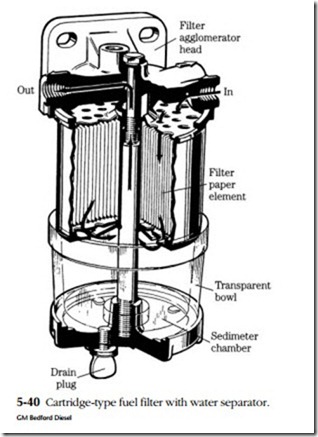Fuel filters and water separators
Most engines incorporate three stages of filtration—a screen at the tank and paper-element primary and secondary filters. Filters are rated by the size of particle trapped: a typical installation would employ a 30-micron primary filter and a secondary
of between 10 and 2 microns. A water separator is often built into the primary filter (Fig. 5-40), which also may include a connection for fuel return and an electric heater to prevent fuel gelling and waxing in cold climates.
When a filter element is changed, entrapped air must be bled as described in Chapter 4.
Related posts:
Frequency Control and Inertial Response Schemes for the Future Power Networks:Synthetic or Artificia...
WIND POWER:OFFSHORE WIND TURBINE TECHNOLOGY
Stress Analysis of 3L-NPC Wind Power Converter Under Fault Condition:New Power Control Methods Under...
POWER FROM WASTE
Transformers:Network Transformers
MARINE POWER GENERATION TECHNOLOGIES:SALINITY GRADIENT POWER GENERATION
Principles of electrical engineering:Energy and power.
Transformers:Loadings
The Current Situation and Perspectives on the Use of Nuclear Energy for Electricity Generation:Slova...
POWER SYSTEM ENERGY STORAGE TECHNOLOGIES:TYPES OF ENERGY STORAGE
Materials for electrical engineering:Introduction and Magnetic materials.
Power Transformers:Inductive Properties.
Starting and generating systems:Wiring
NATURAL GAS–FIRED GAS TURBINES AND COMBINED CYCLE POWER PLANTS:EMISSION CONTROL FOR GAS TURBIN...
Circuit-Level Transient Suppression:Inductive Load Switching.
